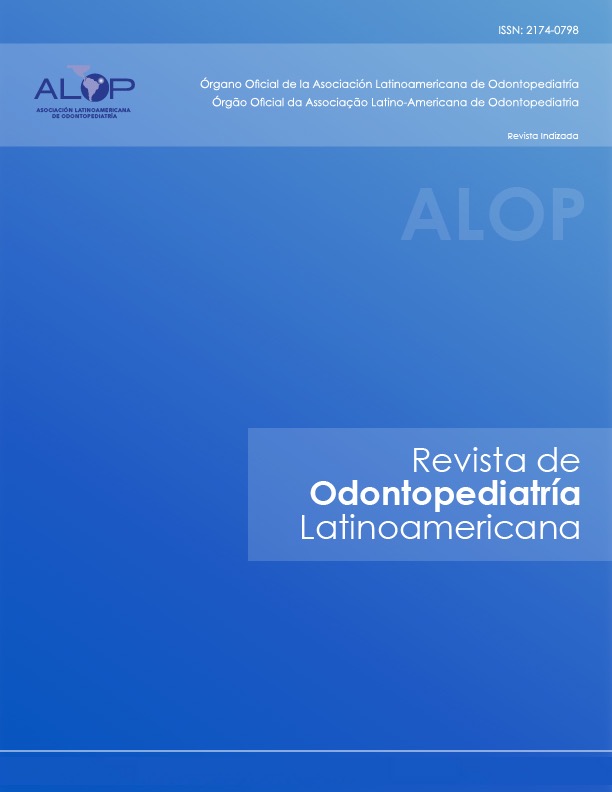Streptococcus mutans inhibition by antagonistic substance produced by Lactobacillus spp isolated from oral cavity in children without caries
DOI:
https://doi.org/10.47990/alop.v10i1.181Keywords:
Lactobacillus, Dental caries, Inhibition, Streptococcus mutansAbstract
Caries is still considered one of the most prevalent diseases worldwide. For this reason, in recent years various prevention strategies have been developed with the purpose of managing this disease. Different oral cavity bacterial species part of the normal microbiota produce antibacterial antagonistic substances. Objective: The objective of this study was to identify some species of Lactobacillus genus that produce antagonistic substances against Streptococcus mutans from saliva of children with and without caries. Materials and methods: Different Lactobacillus strains were isolated from saliva of 60 children with caries, without active decay (rehabilitated) and free of caries. The antagonistic capacity against strains of Streptococcus mutans was studied, by means of tests in double layer, test of the well and about bacterial growth. Results: Lactobacillus strains that produced substances with greater antagonistic capacity were identified as Lactobacillus fermentum by Api test 50 CH. Conclusions: It was found that Lactobacillus fermentum is present in a larger percentage among children without caries which could suggest a natural biological control effect by this bacterial strain.
References
Petersen PE. Global policy for improvement of oral health in the 21st century implications to oral health research of World Health Assembly 2007, World Health Organization. Community Dent Oral Epidemiol. 2009; 37 (1): 1-8.
Simón-Soro A. Solving the etiology of dental caries. Trends Microbiol. 2015;23:2-76.
Xu X. Oral cavity contains distinct niches with dynamic microbial communities. Environ Microbiol. 2015; 17(3): 699-71
Marsh PD. Are dental diseases examples of ecological catastrophes? Microbiology. 2003; 14: 279-94.
Clarke JK. On the bacterial factor in the aetiology of dental caries. Br J Exp Pathol. 1924; 5(3): 141–147.
Li Y. Characterizing Diversity of Lactobacilli Associated with Severe Early Childhood Caries: A Study Protocol. Adv Microbiol. 1; 5(1): 9–20.
Graciano ME, Correa YA, Martínez CM, Burgos A, Ceballos JI, Sánchez LF. Streptococcus mutans y caries dental en América Latina. Revisión sistemática de la literatura. Rev Nac Odontol. 2014; 8 (14): 32-45.
Teanpaisan R, Piwat S, Tianviwat S, Sophatha B, Kampoo T. Effect of Long-Term Consumption of Lactobacillus paracasei SD1 on Reducing Mutans streptococci and Caries Risk: A Randomized PlaceboControlled Trial. Dentistry Journal. 2015; 3(2): 43–54.
Camelo-Castillo A, Benítez-Páez A, Belda-Ferre P, Cabrera-Rubio R, Mira A. Streptococcus dentisani sp.nov., a novel member of the mitis group. Int J Syst Evol Microbiol. 2014; 64(Pt 1):60-5.
Twetman S. Probiotics for caries prevention and control. Adv Dent Res. 2012; 24(2): 98-102.
Güngör öE, K?rz?o?lu Z, Dinçer E, K?vanç M. Who will win the race in childrens’ oral cavities? Streptococcus mutans or beneficial lactic acid bacteria? Beneficial microbes. 2013; 4(3):237-45.
Chuang L-C. Probiotic Lactobacillus paracasei effect on cariogenic bacterial flora. Clin Oral Investig. 2011; 15(4):471-6.
Caufield PW. Oral Lactobacilli and Dental Caries: A Model for Niche Adaptation in Humans. J Dent Res.
; 94(9 Suppl):110S-8S.
Piwat S. Lactobacillus species and genotypes associated with dental caries in Thai preschool children. Mol Oral Microbiol. 2010; 25(2): 157-64.
Yang R. Determining the genetic diversity of lactobacilli from the oral cavity. J Microbiol Methods. 2010; 82(2): 163–169.
Byun R. Quantitative analysis of diverse Lactobacillus species present in advanced dental caries. J Clin Microbiol. 2004; 42(7): 3128–3136.
Cornejo-Ovalle M, Fajreldin V, Werlinger F, Candia O, Cruces G, Farfán J, et al. Mesas de trabajo intersectorial y política de salud oral enfocada a la niñez. Rev Clin Periodoncia Implantol Rehabil Oral. 2015; 8 (3): 261-2.
Ilave MG, Fernández LO, Calderón KM, Villacampa SC. Eficacia de una medida preventiva para el niño con riesgo cariogénico asociada a la estabilidad de pH salival. Odontol Sanmarquina. 2007;10.1:25-7.
Lobos O. In vitro antimicrobial effect of bacteriocin PsVP-10 in combination with chlorhexidine and
triclosan against Streptococcus mutans and Streptococcus sobrinus strains. Arch Oral Biol. 2009; 54 (3): 230.
Abo-Amer AE, Shobrak MY. Partial characterization of a bacteriocin produced by Lactobacillus salivarius isolated from oral cavity of desert foxes. Afr J Microbiol Res. 2012; 6: 6589-99.
Goodfellow, Michael, Fred A. Rainey, and Karl-Heinz Schleifer. Bergey’s Manual® of Systematic Bacteriology: Volume Two The Proteobacteria Part B The Gammaproteobacteria. Springer, 2005.
Ojeda-Garcés JC, Oviedo-García E, Salas LA. Streptococcus mutans y caries dental. CES Odontología. 2013; 26 (1): 44-56.
De la Higuera A. In-vitro susceptibility, tolerance and glycocalyx production in Streptococcus mutans. J Antimicrob Chemother. 1997; 40 (3): 359-63.
Gomez Parada PA, Vives Contardo J. Determinacion de riesgo cariogenico utilizando el cuadro de riesgo de la ficha de odontopediatria y el programa computacional Cariogram, Universidad de Talca, 2008: Estudio piloto.
Hassan YI. Antifungal activity of Lactobacillus paracasei ssp. tolerans isolated from a sourdough bread culture. Int J Food Microbiol. 2008; 121(1):112-5
Busarcevic M, Dalgalarrondo M. Purification and genetic characterisation of the novel bacteriocin LS2 produced by the human oral strain Lactobacillus salivarius BGHO1. J Antimicrob Agents. 2012; 40(2): 12734.
Wannun P. Purification and characterization of bacteriocin produced by oral Lactobacillus paracasei SD1. Anaerobe. 2014; 27: 17.
Rebolledo, M.; Rojas, E.; Salgado, F. Efecto de dos probioticos que contienen cepas de Lactobacillus casei variedad rhamnosus y Lactobacillus johnsonii sobre el crecimiento in vitro de Streptococcus mutans. Int. J. Odontostomat. 2013; 7 (3); 415-419.
Kõll-Klais P, Mändar R, Leibur E, Marcotte H, Hammarström L, Mikelsaar M. Oral lactobacilli in chronic periodontitis and periodontal health: species composition and antimicrobial activity. Oral Microbiol Immunol. 2005; 20 (6): 354-361.
Baca-Castañón ML, De la Garza-Ramos MA, Alcázar-Pizaña AG, Grondin Y, Coronado-Mendoza A, Sánchez-Najera RI, Cárdenas-Estrada E, Medina-De la Garza CE, Escamilla-García E. Antimicrobial effect of Lactobacillus reuteri on cariogenic bacteria Streptococcus gordonii, Streptococcus mutans, and periodontal diseases
Downloads
Published
Issue
Section
License
Copyright (c) 2020 Latin American Pediatric Dentistry Journal

This work is licensed under a Creative Commons Attribution-NonCommercial-ShareAlike 4.0 International License.























